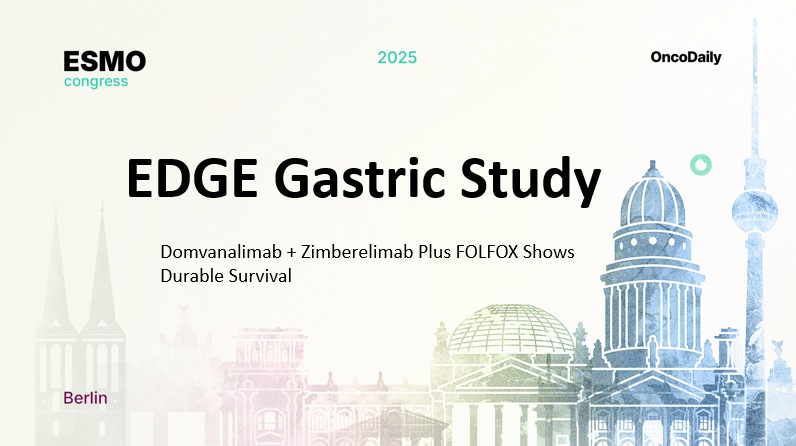At the ESMO Congress 2025 in Berlin, Dr. Yelena Y. Janjigian (Memorial Sloan Kettering Cancer Center, New York, USA) presented updated long-term results from the Phase II EDGE Gastric study (NCT05329766), sponsored by Arcus Biosciences and Gilead Sciences. The trial evaluated the dual immune checkpoint blockade of domvanalimab (Dom)—an Fc-silent anti-TIGIT antibody developed by Arcus—and zimberelimab (Zim)—an anti–PD-1 antibody—in combination with FOLFOX chemotherapy in the first-line (1L) treatment of HER2-negative advanced gastric (GC), gastroesophageal junction (GEJC), and esophageal adenocarcinoma (EAC).
At a 26-month follow-up, the combination demonstrated durable efficacy, achieving a median overall survival (OS) of 26.7 months and median progression-free survival (PFS) of 13.2 months, reinforcing dual PD-1/TIGIT blockade as a promising next-generation immunotherapy strategy for upper gastrointestinal adenocarcinomas.
Background
Despite advances in immunotherapy, long-term outcomes for patients with advanced gastric and GEJ cancers remain poor. While PD-1 inhibitors have become a mainstay of first-line therapy, resistance and limited response durability remain major challenges.
The TIGIT pathway, a key regulator of T-cell exhaustion, has emerged as a complementary target to PD-1, with potential to deepen and sustain immune responses.
The EDGE-Gastric trial (Arm A1) was designed to assess whether dual inhibition of PD-1 and TIGIT, combined with chemotherapy, could enhance anti-tumor immunity and improve survival outcomes in this population.
Methods
Patients received:
- Domvanalimab 1600 mg IV every 4 weeks (Q4W),
- Zimberelimab 480 mg IV Q4W, and
- FOLFOX chemotherapy (oxaliplatin, leucovorin, fluorouracil) every 2 weeks (Q2W).
Primary endpoints included safety and objective response rate (ORR) by RECIST v1.1, while secondary endpoints assessed progression-free survival (PFS) and overall survival (OS).
A total of 41 patients were enrolled, 63% of whom had gastric cancer.
The median follow-up at data cutoff (March 3, 2025) was 26.4 months.
Results
The combination of Dom + Zim + FOLFOX continued to yield durable and consistent efficacy:
- Confirmed ORR: 59% (90% CI: 45–72)
- Median PFS: 13.2 months (90% CI: 9.8–13.8)
- Median OS: 26.7 months (90% CI: 18.4–not estimable)
- 24-month PFS rate: 25.9% (90% CI: 14.8–38.5)
- 24-month OS rate: 50.2% (90% CI: 36.3–62.6)
The benefit was consistent across PD-L1 subgroups:
- PD-L1 positive (TAP ≥1%): ORR 62%, median OS 26.7 months
- PD-L1 high (TAP ≥5%): ORR 69%, median PFS 14.5 months, median OS not yet reached
These findings highlight robust, long-lasting responses, particularly in PD-L1–high tumors, with durable benefit extending beyond two years.
Safety
The safety profile of Dom + Zim + FOLFOX remained manageable and comparable to PD-1–based chemotherapy regimens.
- Immune-mediated TEAEs: 22%
- Infusion-related reactions: 7%
- Grade ≥3 TEAEs: consistent with prior reports
No new safety signals or TIGIT-specific toxicities were observed.
Overall, the regimen was well tolerated, supporting its feasibility in frontline management.Conclusions
At 26 months of follow-up, dual PD-1/TIGIT blockade with domvanalimab and zimberelimab plus FOLFOX achieved prolonged survival outcomes—with a median OS of 26.7 months—and sustained responses in patients with HER2-negative advanced gastric, GEJ, and esophageal adenocarcinoma.
The regimen demonstrated a favorable safety profile and consistent benefit across PD-L1 subgroups, establishing a strong rationale for phase III validation.
The ongoing STAR-221 trial (NCT05568095) will compare Dom + Zim + chemotherapy directly with nivolumab + chemotherapy in the same setting.
You Can Also Raed INTEGRATE IIb Trial at ESMO 2025: Regorafenib Plus Nivolumab vs Chemotherapy in Advanced Gastric and GEJ Cancer by OncoDaily
You can read the full abstract here






